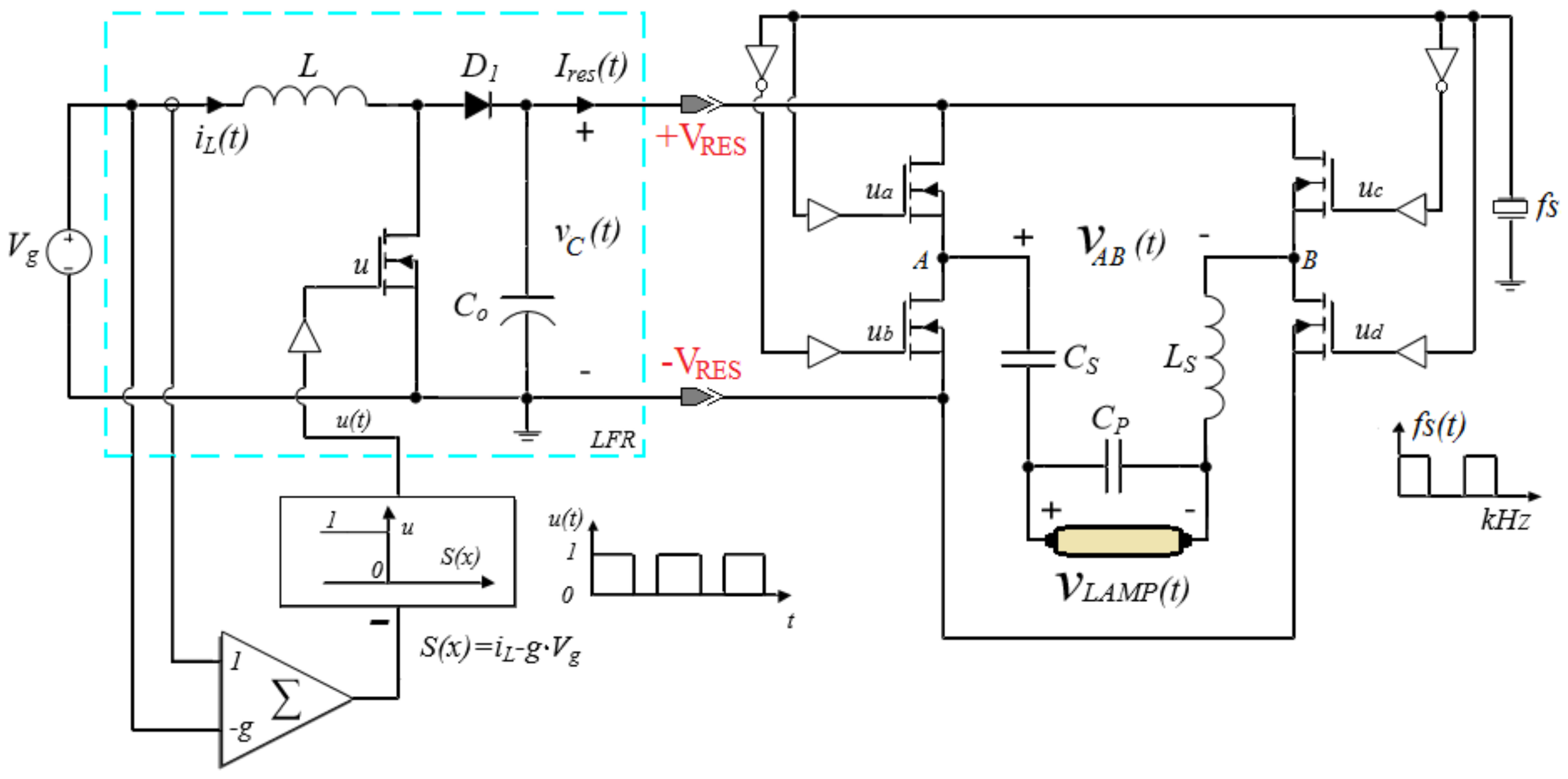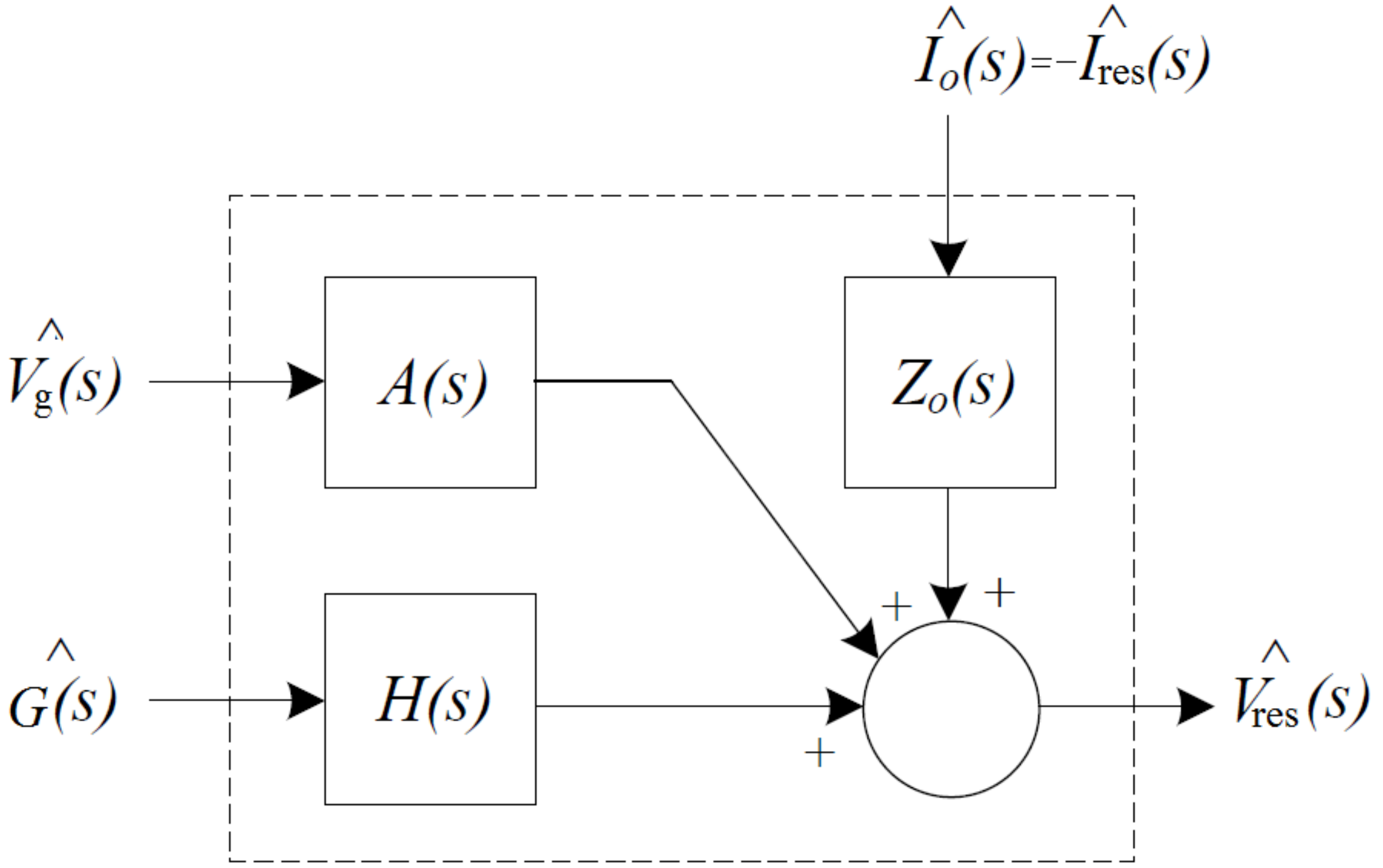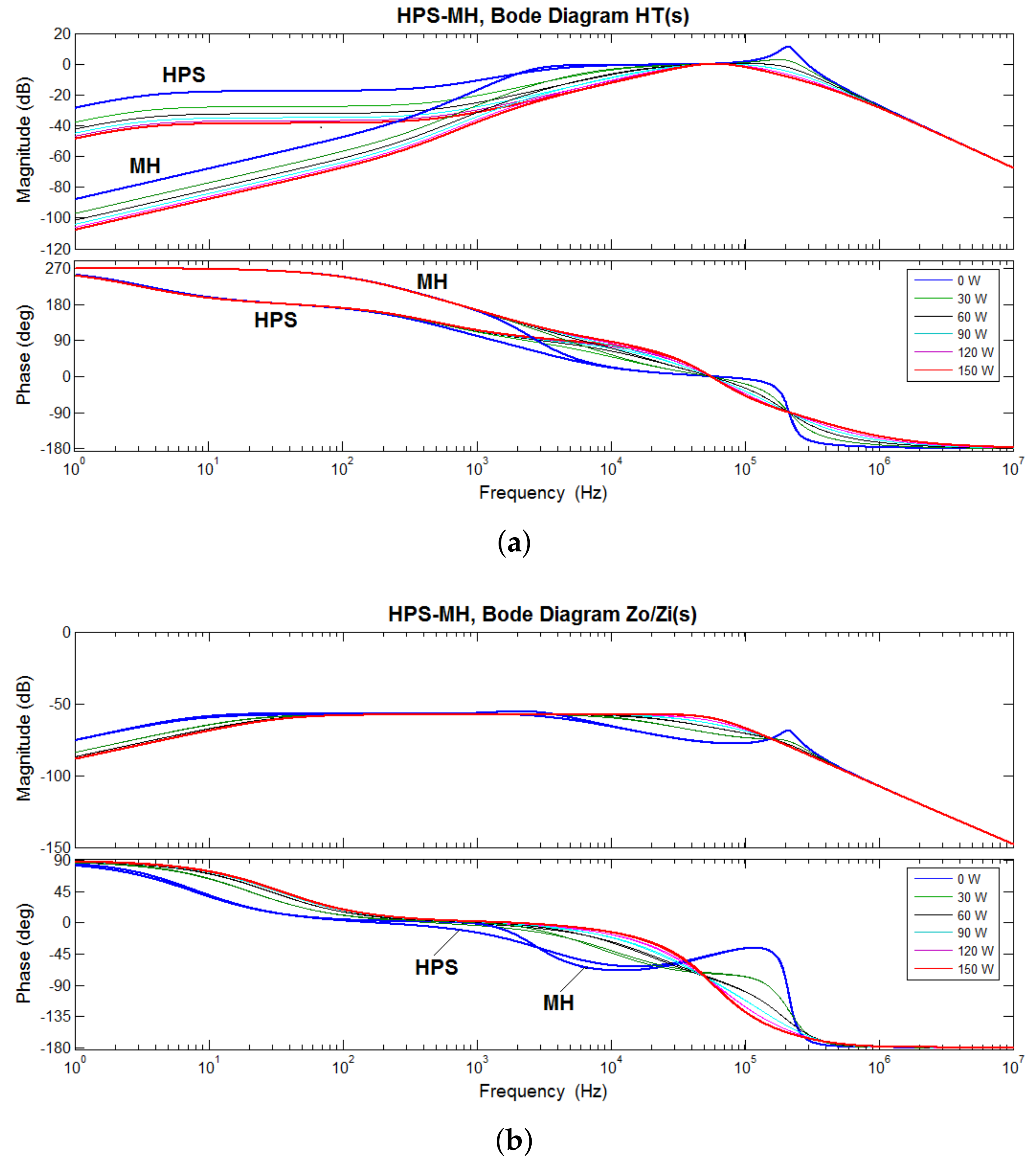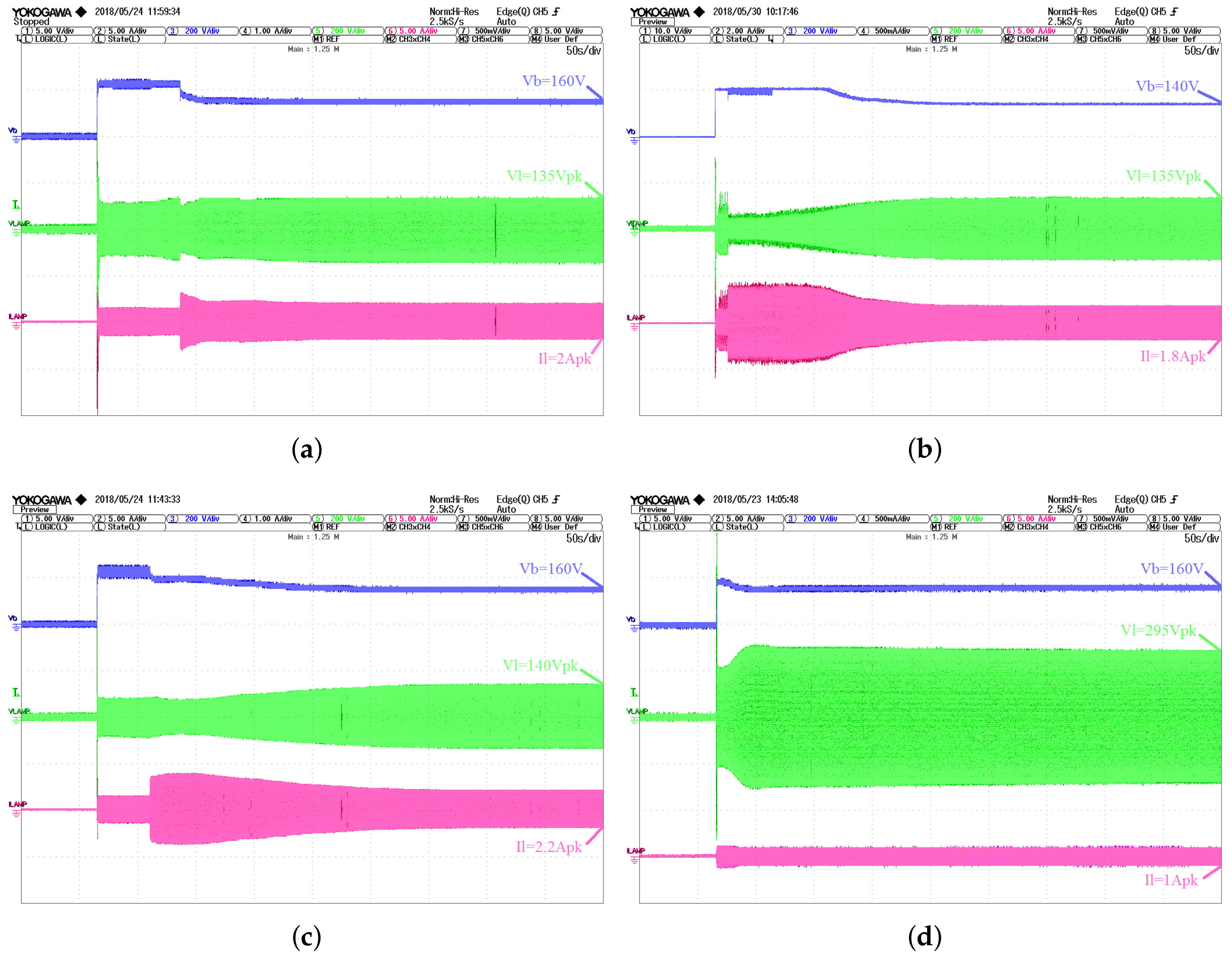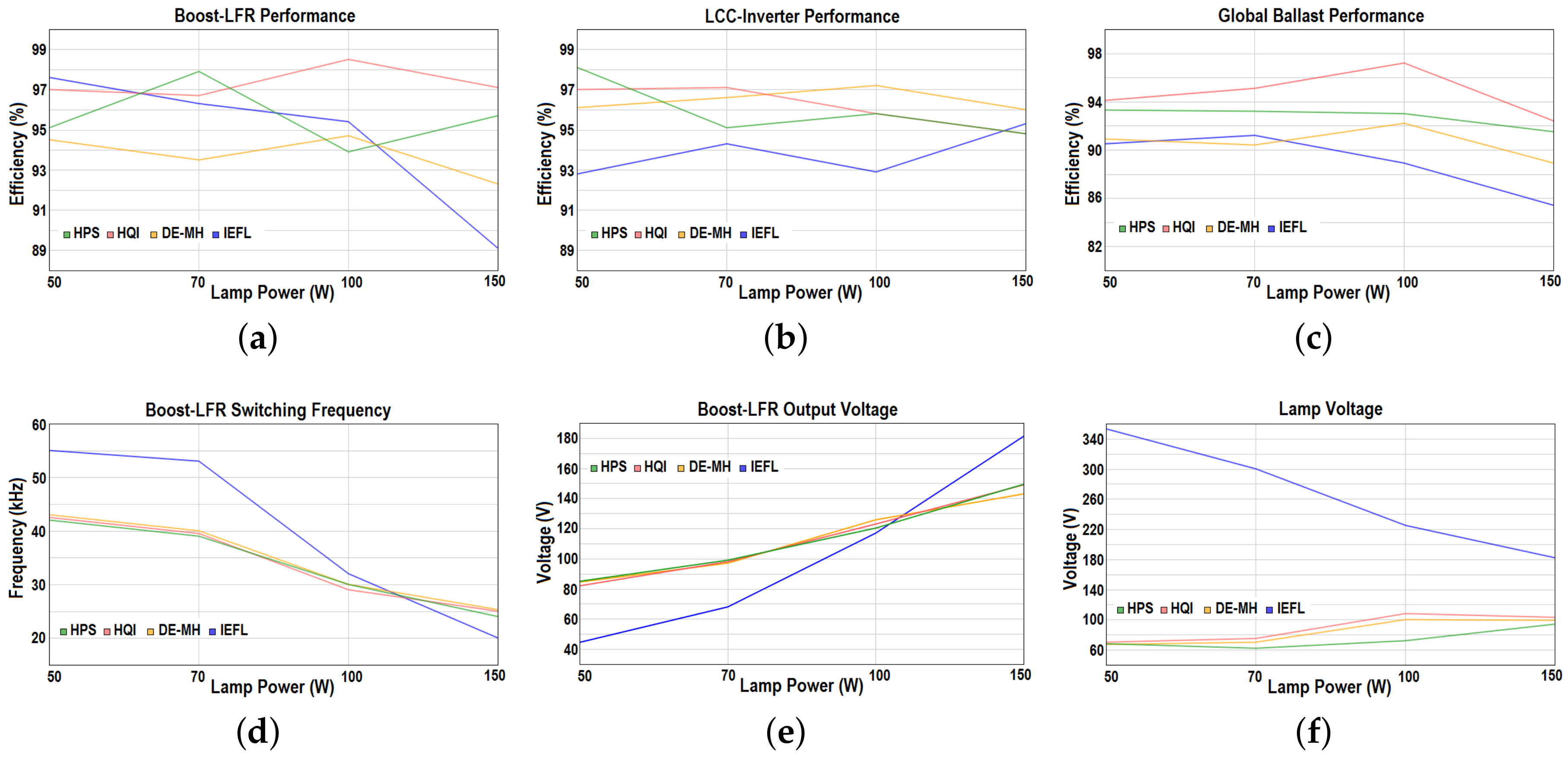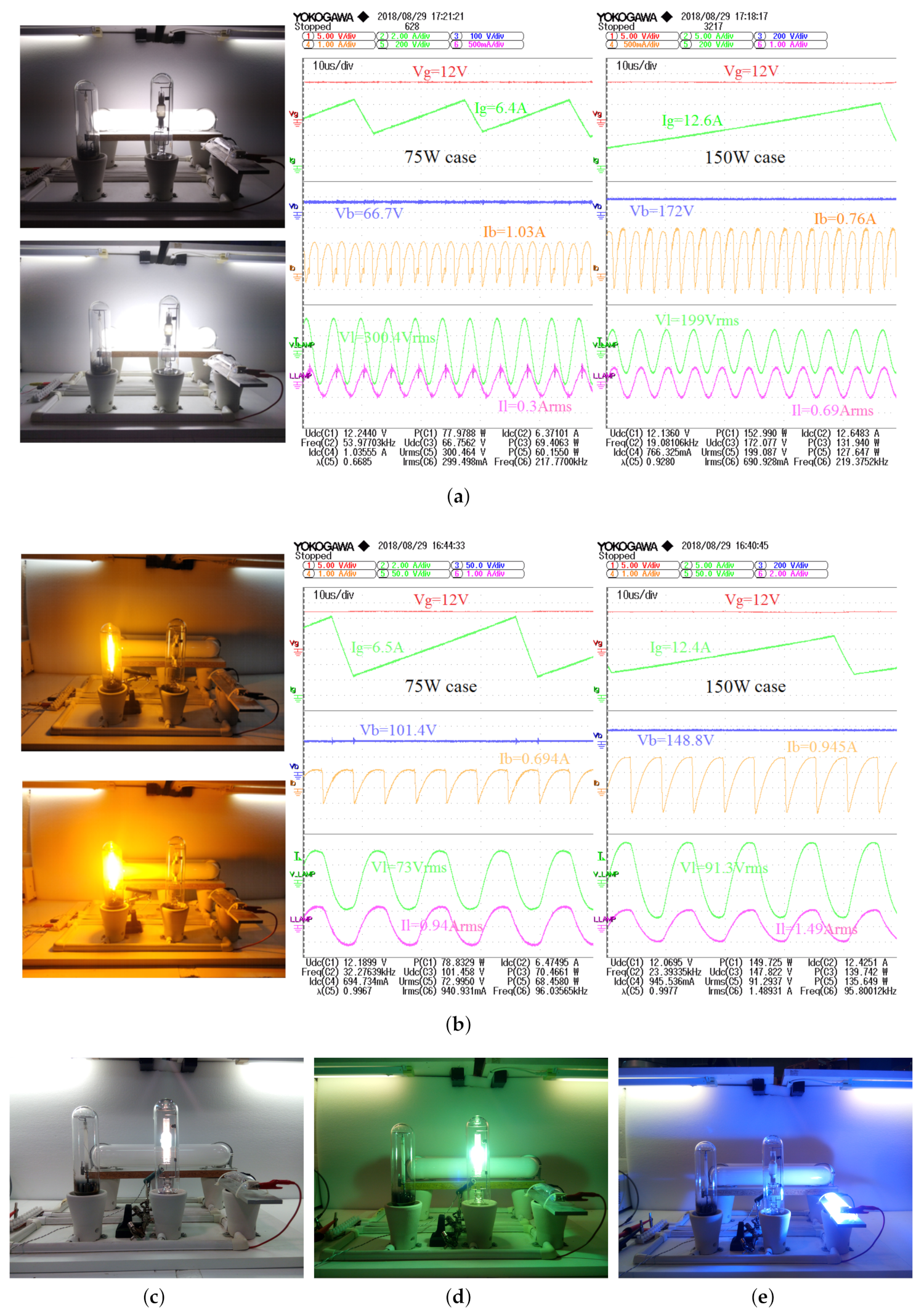1. Introduction
Lighting from electricity accounts for approximately 15–19% of global energy consumption and over five percent of worldwide greenhouse gas (GHG) emissions. It has been estimated that replacing all inefficient on-grid lighting would result in 939 TWh of electricity savings annually, which correspond to approximately 490 million tons of CO
2 [
1,
2]. For that reason, efficient lighting sources, such as light-emitting diodes (LEDs) and discharge lamps, are increasingly used as a simple and cheap procedure to reduce the contribution of electricity consumers to global warming [
3,
4,
5,
6,
7]. In this sense, although LEDs are steadily increasing their rated power and luminous efficacy in terms of lumen/Watt, discharge lamps are still competitive in applications requiring high power and long lifespan. Concretely, for a given discharge lamp type, higher-power bulbs usually have better efficacy than lower-power ones [
8]. In contrast, due to the efficiency droop, the situation is normally the opposite in LEDs, making them more suitable for low-power applications [
9]. Regarding lifetime, although high-performance LEDs last about 50,000 h, and high-pressure sodium (HPS) or metal-halide (MH) lifespan is between 15,000 and 25,000 h, external coil induction electrodeless fluorescents (IEFLs) can last up to 100,000 h with a very little light output depreciation until the very end of its life.
Many types of discharge lamps are available in the market, differing in the type of gas, filling pressure, operating voltage, color rendering index, or efficiency. One of the main differences among them is the way the electrical energy is transferred to the bulb. Whereas conventional lamps use internal electrodes to transfer the energy to the bulb, the magnetic induction electrodeless lamps use internal or external coils to do so. This coil behaves as the primary winding of a transformer, whereas the discharge operates as the secondary one-turn coil.
Although single-stage solutions exist [
10,
11,
12,
13], ballasts for discharge lamps are typically composed of two stages [
14]. The first stage is a buck, boost, or buck-boost stage performing power factor correction (PFC) and providing an approximately constant DC-link voltage. The second stage is a full or half-bridge LCC resonant converter driving the lamp.
In this context, power regulation is the subject of many papers because dimming operation can provide about a 50–60% energy saving [
7,
12,
15]. The issue is still open to discussion because discharge lamp systems are expensive, and light-dimming normally requires a more complex circuitry than traditional systems without light regulation. In high-intensity discharge (HID) lamps, current mode control is the most extended technique [
10], such that power control can be realized by analog multiplication of voltages and currents within the lamp. Also, other techniques have been used, such as controlling the resonant tank input current [
11]. Regarding IEFLs, J. Tae-Kun et al. [
16] present a comparison between two power control methods: the variable switching frequency control and the variable DC-link voltage control method, to conclude that the latter is more suitable for linear dimming operation of the lamp. Later, several authors presented power conversion topologies dedicated to regulating the light in the IEFL [
17,
18,
19,
20] with the aim to compare performance and efficiency in the converters. In all these cases dimming control is achieved by adjusting the DC-link voltage. The common characteristic in all the previous works is the necessity of exactly understanding the lamp behavior, and its electrical characteristics at different power ratings [
21] to achieve power regulation. However, precise lamp modelling also implies that each ballast is designed for a given lamp type, which results in the opposite concept of a versatile design.
In this paper, a novel approach for power control in electronic ballasts is proposed. The approach is based on a conventional two-stage ballast: besides of performing PFC, the first stage has the characteristics of a loss-free resistor (LFR), whereas the second stage simply converts the DC input power into the required AC waveforms at the desired frequency. The LFR is a POPI device [
22,
23] whose output port is a power source which delivers to the load the power absorbed by the emulated input resistance, no matter what type of lamp is connected at the output. Consequently, the power injected in the lamp can be accurately regulated with a simple controller and with no stability issues, no matter what impedance the lamp connected at the output presents. In other words, the proposed ballast does not require lamp modelling. The second stage operates as an inverter, whose switching frequency can be selected depending on the requirements of the lamp. In this sense, the paper also presents a method to design a resonant tank that is compatible with several discharge lamp types. Thanks to these features, the only expected limits on the ballast versatility is the rating of the components used in the power stages. The proposed approach results in three advantageous characteristics. First, the proposed ballast is extremely versatile. Secondly, stability is ensured irrespective of the frequency response of the lamp. Finally, light-dimming control can be achieved easily by adjusting the LFR input power.
The proposed approach could be applied to any discharge lamp. In the paper, we have demonstrated the ballast with a prototype that can drive some of the most common types. Specifically, the paper shows results for an IEFL, a HPS vapor lamp, and two MH lamps.
The remaining part of this article is organized as follows: the proposed ballast and the lamp start-up procedure are described in
Section 2. An appropriate sliding-mode control is applied to the boost converter to impose an LFR behavior in
Section 3. The effect of different lamp models in the resonant inverter design and the ballast stability is analyzed in
Section 4. Experimental results demonstrating the feasibility of the proposed ballast are shown in
Section 5. The conclusions and future research are presented in
Section 6.
2. Proposed LFR-Based Ballast
The operation of the proposed ballast in steady-state combines the features of its two stages, i.e., LFR and resonant inverter depicted in
Figure 1. The LFR stage assures the lamp supply with both constant and adjustable power to regulate the luminosity and protect the lamp. As an advantage, the LFR behavior precludes the instabilities caused by the negative incremental impedance of many discharge lamps.
The resonant inverter stage is required to supply the lamps in AC at high frequency (90–250 kHz). AC supply is needed to avoid electrode wear in voltage driven discharge lamps, and to make the IEFL coils behave like a transformer.
Figure 2 depicts the schematic of the proposed ballast. The LFR is implemented by an appropriate sliding-mode control in a boost converter supplied by low-voltage DC source (such as a car battery) ranging from 12 V to 15 V. The figure shows a DC input, but the proposed approach can also be applied in the case that
is the AC input from a rectifier. Also in the figure, a boost converter is considered, but other topologies (such as the buck-boost, flyback or forward) could be employed if the ballast is supplied from the grid.
The regulation of the lamp requires very different modes of operation: start-up, warm-up, nominal output, and dimming. Thanks to the LFR behavior, the ballast operates as a power source regardless of the mode, and control is straightforward.
2.1. Lamp Start-Up
In electroded lamps, many factors influence the peak voltage required to start the lamp. Among them the distance between electrodes, the gas type and pressure, and in the case of MH lamps, the existence or nonexistence of a third electrode to reduce the strike voltage. When an electroded lamp is OFF, its impedance is an open circuit, and the ballast is unloaded. In pulse-start lamps, a high peak voltage is required, ranging from 1.5 kV up to 30 kV (hot re-strike). In probe-start lamps, due to the third electrode, start voltages are in the range of 500 V or less.
External coil IEFLs are slightly different. When a IEFL lamp is OFF, the lamp input impedance is purely reactive, and equal to the external coil inductance. Thus, the lamp behaves like an unloaded transformer.
In the proposed ballast, the first and the second stages contribute to reach the required voltage to start the lamps, directly inducing the required electric field inside the bulb with the electrodes, or through Faraday’s Law in the external coil IEFL. A single resonant tank is used for all lamps, and the inverter frequency is adjusted to operate the tank a a frequency that provides the required voltage gain from the second stage, which in our case is 224 kHz. As the boost converter is unloaded, its output voltage increases continuously until the lamp starts-up, or the boost output reaches the maximum voltage allowed.
2.2. Lamp Warm-Up
Immediately after the start-up, the lamp voltage drops, and warm-up begins. During this process light intensity increases and, in some lamps, color changes are produced. The voltage increases slowly while the current decreases at similar rate, until the steady-state is reached at the warm-up end. It is important to remark that, although the lamp impedance changes during warm-up, the supplied power is controlled by the LFR stage, so damaging the lamp is precluded. In high-pressure devices like metal-halide (MH) and sodium vapor (HPS) lamps, warm-up can last up to 10 min. In contrast, the steady-state luminous flux of IEFLs is reached in few seconds.
In this period, the lamp impedance is no longer an open circuit, and the gain peak of the resonant inverter decreases. However, the impedances of electroded lamps are quite lower than those of IEFL lamps for the same power, and the resonant inverter gain reduction is less severe with IEFL lamps. In the proposed ballast, this gain reduction is automatically compensated by an increment of the LFR stage gain, but as more severe be the resonant gain reduction, more important will be the increase of the LFR gain, and higher will be the component stress in the boost stage, affecting the global ballast efficiency. To avoid a significant gain increase of the LFR stage, the inverter frequency is reduced from 224 kHz to 90 kHz, when the ballast is driving an electroded lamp. This frequency reduction assures at least, a minimum gain of 0 dB for the resonant inverter, thus limiting the gain increase of the LFR stage. The inverter frequency change is not applied with IEFL lamps because they cannot operate below 150 kHz, and the resonant gain reduction is quite less severe.
2.3. Nominal Operating Point and Dimming
After warm-up, the lamp impedance is approximately constant, lamp voltage and current reach their steady state values, and the ballast continues to deliver constant power. If dimming is required, the LFR stage can reduce the power transferred to the lamp, adjusting the LFR input conductance, and dimming takes place independently of the lamp impedance.
3. Sliding-Mode Dynamics of the First Power Stage
This section shows how the LFR can be realized with a sliding-mode controller. A small-signal model is derived, and its stability is proven.
The LFR behavior of the first stage in
Figure 2 is achieved by a sliding-mode control loop that makes the boost converter input current proportional to the input voltage. Specifically, the switching surface in (
1) forces the input current to track a slow reference
proportional to the ballast input voltage
. Therefore, the lamp active power
is indirectly regulated by controlling the converter input power
through the adjustment of either the LFR input resistance
or the LFR input conductance
g,
Assuming that the boost converter operates in continuous conduction mode (CCM), only two topological changes occur in a period, as shown in
Figure 3. Each converter topology can be represented by means of two linear vector differential Equation (
4), where the corresponding state vector is given in (
5).
Matrices
,
,
and
are given in (
6), where,
represents the current delivered by the boost-based LFR to the resonant inverter stage.
The converter dynamics can be described using the bilinear Equation (
7), where
,
,
and
.
From (
6) and (
7) we obtain
If the invariance conditions [
24]
and
are applied in (
1), the equivalent control
can be derived. The equivalent control
is bounded by the maximum and minimum values of
. In such case, a switching law of the type
induces a sliding regime on the switching surface, ensuring the sliding-mode existence because
The dynamics are then derived as follows. First, the equilibrium point is found assuming constant values of input voltage
and LFR input conductance
in the control loop. Second, the influence of the time-varying components of the mentioned input variables is analyzed as linearized low-frequency signals superposed on their corresponding values
and
G. Considering constant values for
and
G leads to the equivalent control
, ideal sliding dynamics, and equilibrium point
given in (
11)–(
13) respectively.
Assuming now that
is time-varying, the corresponding equivalent control, and ideal dynamics are given by (
14) and (
15) respectively
Variables can be expressed as (
16), as a sum of its DC component and a small-signal term denoted with a hat sign:
Linearizing the differential equation of the output capacitor (
15) around the equilibrium point
leads to the following expression
where coefficients
a,
b,
c,
d,
e, and
f are as follows
Figure 4 shows the block diagram of the boost converter-based LFR small-signal model. The transfer functions of the block diagram are as follows
Considering that
, it can be seen that the control to output transfer function
given above is stable, because the following condition is always satisfied
4. Design of the Resonant Tank and System Stability
In the literature there are some works analyzing the
resonant filters of electronic ballasts supplying IEFL lamps with dimming operation [
16]. Nonetheless, most of these papers do not consider the lamp model, except for [
21] where a precise IEFL equivalent model was introduced.
In fact, the resonant converter cannot be analyzed in a classical way, i.e., when the load is a resistor, because its behavior depends on the nonlinear nature of the lamp. Consequently, the input-output voltage transfer function
of the converter will depend on the lamp impedance
, which, in turn, is also function of the power
P handled by the lamp.
In the design of the proposed ballast, two lamp models are used: (a) a general first-order model with a right half-plane zero and a stable pole, and (b) the IEFL model introduced in [
21]. Four lamps have been tested in this paper: a 150 W IEFL from Osram, a 150 W HPS vapor lamp from Sylvania, and two 250 W probe-start MH lamps, from Osram and I-Quarium, respectively. The latter three lamps have internal electrodes and can be described with the first-order model.
4.1. First-Order Lamp Model
All lamps with negative incremental resistance can be described with this model. The impedance parameters are the equivalent DC resistance
, a real half-plane pole
, a right-plane zero
, and a negative resistance
The zero is located between 10 and 10
3 rad/s, and the pole between 100 and 10
4 rad/s. In reference [
25] the parameters of an specific HPS lamp with
= −3141.5 rad/s and
= 18.8 rad/s are given, whereas in reference [
26], similar parameters for a 150 W MH lamp with
= −1850 rad/s and
= 10,690 rad/s can be found. This illustrates the great variability in the location of
and
. The ballast operation with HPS and MH lamps is simulated using the values of [
25,
26] and the real resonant tank values (
μH,
nF, and
nF) of the ballast prototype. The corresponding results are given in
Table 1, where
.
4.2. IEFL Lamp Model
The IEFL model proposed here is directly derived from the model presented in [
21] but has been improved by considering the saturation of the IEFL transformer core. As a result, the parameter
(which was constant in [
21]) is now power dependent. The remaining model parameters continue to be power dependent as they were in [
21]. According to the circuit in
Figure 5b, the parameters that can be seen from the transformer primary side are: the core losses
, the inductance
, the lamp resistance
which represents the power transformed into light, and the lamp capacitance
. Expression (
25) models the IEFL lamp impedance. According to the procedure given in [
21], the parameters of the model of the 150 W IEFL lamp used in the experiments were obtained. Then, these parameters were used to simulate the behavior of the proposed ballast using, as in the previous case, the resonant tank values (
μH,
nF, and
nF). The results of the simulation are given in
Table 2.
4.3. Design of the Resonant Tank
In the proposed ballast, the LFR behavior controls the power delivered to the lamp and makes it possible to provide light-dimming, if necessary. On the other hand, the resonant inverter stage is required to supply the lamps in AC, but also to increase the ballast voltage gain during the lamp start-up by means of the tank resonant gain peak.
The resonant tank voltage gain
, can be found from the inverter transfer function in (
23) by
. Nevertheless, to simplify tank design, a reduced gain function
is used. This function can be easily derived from (
23) considering the lamp as a power dependent resistor
. By defining the following normalized parameters,
two different expressions are obtained for the resonant tank voltage gain
.
where
A is the parallel to series capacitance ratio,
is the undamped resonant frequency,
is the loaded quality factor,
is the series resonant frequency,
is the series characteristic impedance, and
is the series quality factor.
Figure 6 depicts the frequency response of
for different values of lamp power and resistance. There are two different resonant frequencies, i.e., the series resonant frequency
, around 90 kHz, and the main resonant frequency
, slightly below 250 kHz. The values of the tank components, namely
μH,
nF, and
nF are obtained by solving a set of equations as explained below.
The resistive part (active power) of any lamp impedance is extremely variable with the lamp power, aging, and type of lamp. In fact, in common lamp types, . As the lamp power regulation is ensured by the LFR stage, the inverter stage is only used to provide the appropriate high-frequency AC signal to the lamp, once the lamp is started.
If the lamps are supplied at the series resonant frequency
, the series capacitor
and inductor
impedances are mutually cancelled, and the resonant inverter has little effect on the lamp regulation because the gain is
= 0 dB at any load. This choice is the first design constraint, and can be posed as follows
A notable exception is the IEFL lamps. These lamps include a transformer coil to transfer the energy to the plasma, which is usually designed to work optimally in the range of 200–250 kHz. Besides, they also exhibit a higher input impedance (
) than other lamp types, working at higher voltages. As a result, to avoid a boost stage extreme voltage gain, part of the required gain can be supplied by the resonant tank through the second resonance. The frequency of this second resonance is noted
, and the voltage gain at this frequency
corresponds to the second and third tank design constraints, shown next:
The voltage given by the third constraint up to 10 kV should be sufficiently high to start-up not only probe-start lamps as proposed in
Section 2, but also in most of pulse-start lamps. In fact, higher voltage peaks can be obtained by increasing
. Nevertheless, this increases the slope (as shown below in (
33)) of
around
, making the operation at 90 kHz with gain of 0 dB, in a wide range of loads, more difficult. This mode corresponds to the flat region in
Figure 6. There is a trade-off in the value of
, so that increasing
produces higher resonant peak gains
, but deteriorates the flat region around
for any given load, where the gain
is approximately 0 dB.
To maximize the bandwidth of the flat region,
must be minimized. In the following expression, the effect of increasing
can be clearly identified.
4.4. Ballast Stability Analysis
The stability of the cascade connection of the two converters will be ensured if the output impedance modulus of the first stage is smaller than the input impedance modulus of the second stage for all operating frequencies [
27].
Figure 7 depicts the Thévenin’s model of the cascade connection of the LFR stage and the resonant inverter.
is the output impedance of the LFR and
is the input impedance of the inverter. From
Figure 7, the following expression holds
Therefore, the stability condition can be expressed as follows
Moreover, from (27) and (28) it is derived
Besides, the resonant inverter input impedance
is given by
where
must be replaced by expression (
24) in case of using a HPS or MH lamp, or by (
25) in case of an IEFL lamp.
It is worth remarking that the validity of the small-signal analysis depends on the linearity of the dynamics of the system. In this sense, when a lamp is operated at high frequency its dynamic behavior is much more linear than when operated at small frequency, thus extending the validity of the small-signal models. As an example, the voltage and current waveforms in a discharge lamp are much less distorted, and more sinusoidal, when they are supplied at 50 kHz than when are driven at 50 Hz [
15].
Also, it is worth mentioning that the boost output impedance has low-pass filter characteristics, which ensures the system rejection to high-frequency perturbations, i.e., the higher is the frequency of a possible perturbation, less is the boost converter affected. Moreover, the resonant tank is used to transfer the power to the lamp at high frequency, between and , just within that frequency band where the boost output impedance is much lower than at zero frequency.
The Bode diagrams depicted in
Figure 8a and
Figure 9a have been plotted using the data of
Table 1 and
Table 2 respectively. Two cases can be distinguished in
Figure 8a depending on the position of the pole
and zero
of the lamp. As it can be seen in the Bode diagram of
Figure 8b, and according to (
35), the stability of the ballast is not affected by changes in
and
over a wide range. As an example, according to
Table 1, the ratio between the pole positions of the MH and HPS cases is
and the ratio between zeros is
. The values of
Table 2 and
Figure 9b correspond to an ENDURA IEFL lamp used in the experiments. The overall result, shown in
Figure 8b and
Figure 9b proves that
is well below 0 dB, which ensures the stability of the cascade connection.

